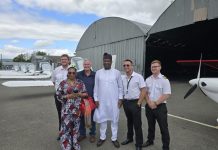The continued recovery in manufacturing and global trade, alongside a rise in business confidence, has fostered confidence, investment and growth in airports across the world, Airports Council International (ACI) World’s Airport Economics Report has revealed.
This stability has reinforced the value of the industry for investment and increased competition continues to shape the industry and its capacity to generate revenues. The report has found aeronautical revenue generated from airport charges per passenger in real terms has remained stable – in the realm of US$10 per passenger. Using aeronautical revenues as an alternative for airport charges, charges are increasing globally at the same pace as global demand. This is clear demonstration that the calls for tighter and rigid economic regulation for airport charges are unfounded, according to ACI.
The report also found that it is undeniable that future growth in air transport demand will come from emerging and developing economies, predominantly from the Asia-Pacific region. In 2016, airports located in emerging and developing economies occupied 45% of global passenger traffic across the world’s airports. By 2040, this share is expected to increase to 62%. By that time, passenger throughput at airports in emerging and developing economies will have 1.6 times the passenger traffic of airports in advanced economies.
The Airport Economics Report and the Airport Key Performance Indicators for the 2016 fiscal year are derived from comprehensive data from a sample of more than 900 commercial airports. The publication is a concise snapshot of selected drivers of the world’s airport industry. It provides a comprehensive in-depth analysis of the financial and economic performance, on both the aeronautical and non-aeronautical (commercial) sides of the business.
“Airports are essential to the economic development of cities, countries, and regions and the continued recovery in manufacturing and global trade alongside the rise in business confidence has fostered growth in passengers and cargo across the world,” said Angela Gittens, Director General, ACI World.
“Since 2010, global passenger traffic has been growing at an average rate of 5.5% annually which is testament to the resilience of the industry.
“While there are predictions of looming challenges on the horizon – including inflationary pressures and a protectionist threat in some major economies – passenger traffic has, remained on an upward trajectory across the globe at airports in responding to demand in both advanced and emerging economies.
“To keep pace with this demand, however, airports must be able to invest, improve and grow. Charges and non-aeronautical revenues are major sources of funds for airports to invest in infrastructure and service improvements. Disproportionate efforts to restrict or regulate this should be avoided, especially considering airport charges have remained both stable and reasonable in response to the strong competitive pressures that now shape the airport industry.”
Cost and investment
The airport cost structure continues to be characterized by predominantly high fixed costs necessary for maintaining and operating the infrastructure components. In 2016, operating expenses made up 64.7% of total costs, the remaining proportion allocated to capital costs.
Findings continue to reveal the fact that airports are asset-intensive businesses that require many years to recover the significant capital investments in runways and terminals. The scale of current and forecast demand at airports clearly indicates a need for increasing levels of investment to maintain and enhance capacity at an appropriate level of service quality.
Consequently, airport charges and non-aeronautical revenues are major sources of funds for investment. To respond to the growing need of airlines and shippers, airports should be permitted to retain and invest these revenues to finance future investments or to pay to shareholders based on the finances of the airport.
The potential of non-aeronautical revenues
The report reveals that the structure of airport revenues remained stable over the last six years. While non-aeronautical revenues continue to be an important source of income for airports, most revenues came from aeronautical related-activities. Airports are strongly encouraged to develop non-aeronautical activities and maximize non-aeronautical revenues at their facilities. In fact, they should not be subject to any limitations on profitability as they are not derived from aircraft operators and are generated in a competitive market environment.
Global passenger traffic growth
The airport traffic at world level has grown consistently over the last three years. According to ACI’s preliminary statistics, passenger traffic posted 6.6 % growth in 2017. Furthermore, the Airport Economics Report reveals that passenger traffic continues to follow the rhythm of its own drum, posting annual growth rates above historical averages.
However, to continue serving the needs of this demand, airports must take a long-term perspective to their business and ensure capacity improvements. Equally important, in this dynamic competitive environment, airports are forced to set competitive charges, offer incentives and rebates, and invest in quality enhancements to maximize their benefits to effectively follow traffic growth.
As businesses, airports continue to be critical contributors to global trade
In 2016, airports continued to focus on the objective of meeting not only the needs of airlines but also of passengers, governments and the communities they serve. The 2017 Airports Service Quality (ASQ) Awards reflected the increasingly competitive airport operating environment. Continuous service improvement is a key ingredient in business performance. In this context, practices, regulations and policies must be crafted to balance the needs of the global airport industry.
The industry continues to serve as engines of growth. In 2016, airport revenues surpassed the US$160 billion mark, contributing to Gross Domestic Product. Revenues grew at a rate comparable to growth in passenger traffic – both in the realm of 6%, testifying to the stability of unit revenues in real economic terms over time.
To keep pace with the rapid passenger traffic growth in an increasingly commercial and competitive business environment, airports must be able to collect sufficient revenues to finance their investments in airport infrastructure and operations, and to maintain a level of service which is broadly acceptable to all users.
Customer experience remains a top priority
The industry experienced efficiency gains on the operational level. It is a positive sign and evidence that airports have clearly focused their efforts in the improvement of airport operations to better serve their customers.
















